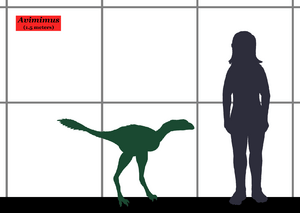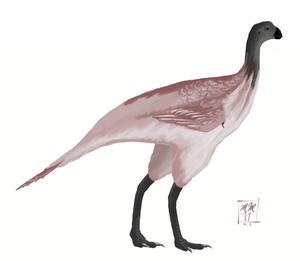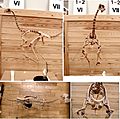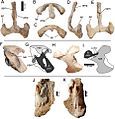Avimimus facts for kids
Quick facts for kids AvimimusTemporal range: Upper Cretaceous
|
|
|---|---|
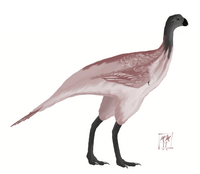 |
|
| Life restoration of Avimimus portentosus. | |
| Scientific classification | |
| Kingdom: | |
| Phylum: | |
| Class: | |
| Superorder: | |
| Order: | |
| Suborder: | |
| Infraorder: | |
| Family: |
Avimimidae
Kurzanov, 1981
|
| Genus: |
Avimimus
Kurzanov, 1981
|
| Species | |
|
|
Avimimus means "bird mimic." This dinosaur was a fast, light, bird-like theropod. It lived about 70 million years ago in what is now Mongolia. Avimimus may have even had feathers!
Description
Avimimus was a small dinosaur. It was about 1.5 meters (5 feet) long. That's about the size of a human!
Its skull was small for its body. But its brain and eyes were quite large. The bones protecting its brain were big. This suggests Avimimus had a big brain for its size.
What it Ate
The jaws of Avimimus looked like a parrot's beak. They were thought to have no teeth. However, some later discoveries showed small teeth. These teeth were at the very front of its upper jaw.
Because of its small teeth, scientists think Avimimus might have eaten plants or both plants and meat. One scientist, Kurzanov, believed it ate insects.
Body Features
The hole where the spinal cord connects to the brain was very large. This also suggests its skull was light. Its neck was long and thin. The bones in its neck were longer than those of other similar dinosaurs.
Its front limbs were short. The bones in its hands were joined together, much like in modern birds. A ridge on its lower arm bone (the ulna) might have been where feathers attached. Scientists now widely agree that Avimimus had feathers. However, most do not think it could fly.
The hip bones of Avimimus were very wide. Not much is known about its tail. But its hips suggest it had a long tail. Its legs were very long and thin. This means Avimimus was a very fast runner. The leg bones show it was quick on its feet. Its shins were long compared to its thighs. This is common in animals built for running. It also had three-toed feet with narrow, pointed claws.
Images for kids
See also
 In Spanish: Avimimus para niños
In Spanish: Avimimus para niños


